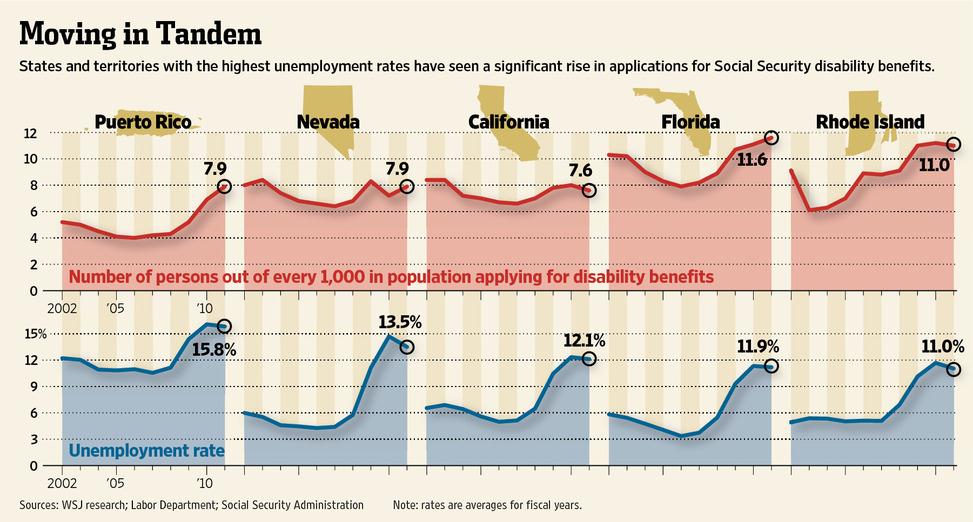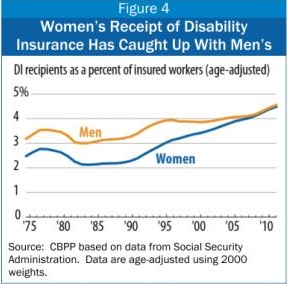Beginning in December 2007, the United States suffered an economic downturn considered to be the worst financial crisis since the Great Depression. During this time period, layoffs increased at an alarming rate. In the fourth quarter of 2007 there were 5.7 million layoffs. By the first quarter of 2009, that number had quickly grown to 7.6 million—a 34% increase. The unemployment rate grew from 5.0% in December, 2007 to 9.5% by the end of the recession in June 2009.
As the unemployment rate reached new highs, so did the number of applicants for Social Security Disability benefits. The number of disability claims in the United States climbed 21% from 2008 to 2009, reaching 2.8 million. The graphic below demonstrates the connection between the unemployment rate and the number of disability applications.

Stephen Goss, the Chief Actuary of the Social Security Administration, reported that the 2008-09 recession led to a nearly record breaking high of “disability incidence”—the number of healthy workers becoming newly disabled.
Although the rapid growth of disability claims would seem to indicate a general decline in the nation’s health, the coinciding rise and fall of the unemployment rate suggests that there may be a different explanation.
Goss suggests that an increase in disability claims during an economic downturn is to be expected. He comments, “When employment is good—when employers are trying to employ lots of people—people with impairments, like everyone else, find it easier to find a job."
Unfortunately, when employment is bad, individuals with disabilities are among the first to be laid off. In an economic downturn, employers who were previously willing to accommodate individuals with disabilities can no longer afford to do so. Older, partially disabled workers lose their jobs and are forced to seek out other ways to support themselves.
An academic study conducted by Matthew Rutledge reports that jobless individuals often turn to disability benefits once they have exhausted their unemployment insurance. This suggests that when jobs are scarce, individuals who would have previously worked despite a disability are turning to Social Security Disability benefits.
Is the Economic Downturn Responsible for the Current Instability of the Social Security Disability Program?
The economic recovery from the most recent recession has been the slowest in U.S. history. The unemployment rate is still high, and the Social Security Disability Insurance trust fund is projected to be insolvent by 2016. The correlation between the unemployment rate and the number of Social Security Disability applications has raised concerns that the marginally disabled, unemployed population has expanded the Social Security Disability program beyond its intended purpose of assisting the disabled.
According to data provided by the Social Security Administration, the percentage of applicants approved for benefits has not changed to counterbalance the increase in applications. This means that, although the approval rate from 2007 to 2010 remained at about 35%, the increase in applications has led to an increase in disability awards.
The following table demonstrates the growth in approved disability applications:
| Year | Applicants | Annual Change | Awards | Annual Change |
| 2007 | 2,190,196 | 2.63% | 823,106 | 1.29% |
| 2008 | 2,320,396 | 5.94% | 895,011 | 8.74% |
| 2009 | 2,816,244 | 21.37% | 985,940 | 10.16% |
| 2010 | 2,935,798 | 4.25% | 1,052,551 | 6.76% |
| 2011 | 2,878,920 | -1.94% | 1,025,003 | -2.62% |
*Data from the Social Security Administration
Although the poor economy has contributed to the rapid growth of the Social Security Disability program, Kathy Ruffing, senior fellow at the Center on Budget and Policy Priorities, suggests that the rise in disability rolls can also be attributed to demographic changes:
- An aging U.S population: The large number of people born between 1946 and 1964, known as the Baby Boomers, is heading toward retirement age. However, aging often takes a toll on the human body long before retirement. As this age group has gotten older, the number of disability cases has grown substantially.
- More women are qualifying for benefits: To qualify for disability benefits, workers must have maintained employment for at least one quarter of their adult lives, including five of the past ten years. Until relatively recently, a very small number of women had worked long enough to meet these requirements. In the 1970’s and 80’s a significantly large number of women joined the work force and now qualify for disability benefits. The following graphic from Ruffing’s research demonstrates the increase in female disability beneficiaries.
- The Social Security Full Retirement Age was raised from 65 to 66: Once disabled workers reach full retirement age, they receive retirement benefits. The increase of the retirement age delayed retirement benefits for a large number of people, causing them to apply for disability benefits. According to Ruffing, “In December 2011, more than 400,000 people between 65 and 66 — nearly 5 percent of all DI beneficiaries — collected disabled-worker benefits; under the rules in place a decade ago, they would have been receiving retirement benefits instead.”

Conclusions
The financially strapped Social Security Disability program has become the focus of national scrutiny. Media stories and academic studies are quick to credit the bad economy for the program’s instability. Although the cause is still being debated, it is evident that the disability rolls have grown rapidly—in a manner that, financially, cannot be sustained.
The flood of new applications has drastically slowed the approval time and the Social Security Administration cannot keep pace. The backlog of applications is keeping the severely disabled from getting the benefits they need to survive. With the Social Security Disability Insurance trust fund running low and the application process often taking up to two years, the need for change is imminent.
The economic downturn and the rise in Social Security Disability rolls are undoubtedly connected. This indicates that, if the economy were to heal, the number of people applying for disability benefits will decrease. However, there are many factors that have led to the program’s rapid expansion and unfortunately, there is not one clear-cut solution that will address all of them.
In the coming weeks policy makers will reach decisions to implement tax increases and spending cuts in an attempt to remedy the country’s budget deficit. As of right now, it is unclear how these changes will affect the Social Security Disability program. One thing is evident-- If a solution is not found quickly, the future is uncertain for the countless individuals who depend on disability benefits.
Sources:
Heritage Foundation calculations using data from the Bureau of Labor Statistics, “Job Openings and Labor Turnover Survey”/Haver Analytics, 2007–2009.
Bureau of Labor Statistics, Spotlight on Statistics: The Recession of 2007-2009, http://www.bls.gov/spotlight/2012/recession (February, 2012).
Michael A. Fletcher, Jobless are Straining Social Security's Disability Benefits Program, http://www.washingtonpost.com/wp-dyn/content/article/2010/09/13/AR2010091306493.html (September 14, 2010)
Damien Paletta and Dionne Searcey, Jobless Tap Disability Fund, http://online.wsj.com/article/SB10001424052970204296804577121392750460030.html (December 28, 2011).
Kathy Ruffing, Social Security Disability Insurance is Vital to Workers with Severe Impairments, Center on Budget and Policy Priorities (August 9,2012)
Matthew S. Rutledge, THE IMPACT OF UNEMPLOYMENT INSURANCE EXTENSIONS ON DISABILITY INSURANCE APPLICATION AND ALLOWANCE RATES (April 2012)